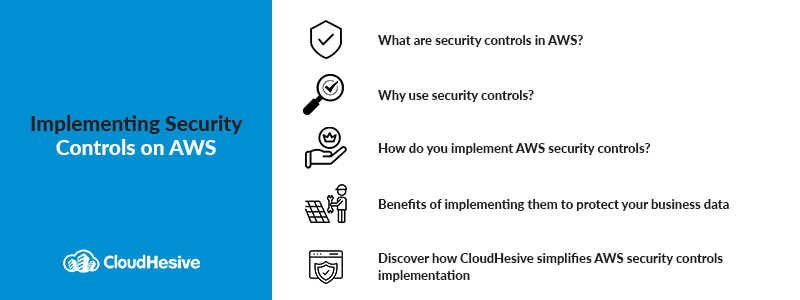Secure your assets with AWS security controls
AWS security controls provide users with a safe solution for cloud-based managed services. Meet all your security goals and compliance requirements using AWS security controls. They offer continuous detection and monitoring to protect every network control point and data in transit or storage. You can configure security controls to automatically kick off security issue investigations and provide security compliance status for audits or tracking.
Learn more about AWS security controls, their benefits, and how to simplify the implementation process.

What are security controls in AWS?
Security controls in AWS are tools and procedures used to prevent a loss of business assets or unauthorized access to the network. Security controls protect the confidentiality, integrity, and availability of network systems, applications, and data. AWS provides a full suite of security control tools that provide proactive and continuous security for your business assets.
Properly implemented security controls in AWS help prevent threat actors from exploiting network or system security vulnerabilities and gaining authorized access to data, hardware, or software. Security controls also continuously monitor, detect, and respond quickly and thoroughly to a security incident. The idea of paying a ransom for your data, allowing a data breach, or losing access to your network keeps many IT professionals awake at night. Use security controls to keep your systems safe and fully monitored.
Examples of security controls include:
- Require multi-factor authentication for all system users and application access
- Create logs and audit records of all system activity to know who, when, and what accessed at any given time
- Encrypt all sensitive data
- Store audit logs and records outside the network securely
- Patching systems or shutting down processes ensure protection when a security incident occurs.
Security controls come in three primary flavors:
- Preventative
- Represents your first line of defense to prevent unauthorized access to networks, data, or business assets.
- Involves defining and setting access permissions for users across the system.
- Detective
- Your second line of defense that notifies when a preventative security control has been bypassed or compromised.
- Designed to detect, log, and send alerts when a security incident occurs.
- Responsive
- Performs an immediate response to a threat.
- Contains the threat and takes actions to safeguard the system, data, and business assets.
If your system runs within the AWS infrastructure, aren’t you already covered for security? Not entirely. AWS provides base security for the infrastructure. AWS provides base security and tools for the infrastructure, but users are responsible for implementing the security controls and protocols to protect their business data and systems.
Why use security controls?
All businesses need an effective security strategy to secure data, users, and the system. Security controls provide critical business protection. Business data is extremely valuable, making it a constant target for theft, ransom, or public exposure. Business data and the networks managing the data provide employees with a workplace, business analytics, and finance and accounting processing.
Essentially business networks and data are the lifeblood of a business and need protection. There’s also the issue of regulatory compliance. Government fines are significant for businesses that allow or improperly respond to or manage data breaches. Plus, the negative financial impact as well as a loss of trust of customers.
Using security controls provides a solid security governance strategy. Protect your business by building a security governance strategy based on security policy, control objectives, standards, and security controls. One significant benefit of using the AWS infrastructure is having access to all the security tools one needs to protect business data effectively and efficiently.
How to implement AWS security controls?
Implementing security controls on AWS involves using several tools to provide preventative and responsive security. AWS also provides expertise through its partner network as well as online documentation.
The first step of the implementation is creating a security policy and security governance strategy. Determine what security is required to protect your business data and system. Find the full list of tools and AWS security managed services for your security controls.
The top AWS security tools and their benefits include:
- AWS CloudTrail
- Monitors systems by recording API requests, SDK deployments, management consoles, accounts, services, and command-line actions
- Generates event logs for troubleshooting security incidences and providing compliance auditing
- AWS WAF
- Enables firewall protections with custom business rules to protect from SQL injections and XSS (cross-site scripting) attacks
- AWS Inspector
- Provides system security evaluations and lets you know where vulnerabilities exist within your system
- AWS Cognito
- Provides identity and access management
- Detects brute force attacks as well as identify invalid login attempts
- Integrates with Microsoft Active Directory, Google, and Facebook login access
- AWS CloudHSM
- Generates encryption keys using HSM (hardware security models) and is stored on your AWS deployments
- AWS CloudFront
- Enables business systems to access and transfer data securely at higher speeds
- Protects data security and systems from DDoS threats
- AWS GuardDuty and Security Hub
- Leverages the power of machine learning to detect anomalies in the system
- Monitors system continuously
- AWS Macie
- Fully managed data security service that uses machine learning and pattern matching to protect and secure data
- AWS Config
- Continuously audits and records all AWS resources on your system
- Generates a full inventory of system configurations in use and alerts you if anything changes
Use the tools in AWS to configure your security, leverage AWS-managed security services, or use the services of a qualified AWS partner that can do all this work for you.
Discover how CloudHesive simplifies AWS security controls implementation
Security controls in AWS help prevent security incidents and reduce system vulnerabilities. Additionally, AWS security controls provide tools that continuously monitor, detect and respond to all suspected security incidents. Protect your business, data, and network assets with AWS security tools.
Have questions on the AWS security tools or controls and how to implement them on your system? CloudHesive provides expertise and support using the entire AWS cloud and infrastructure system, including securing business data assets and systems. As an Amazon Managed Services partner and Amazon Premier Partner, CloudHesive helps any organization take full advantage of all the AWS tools and features, including security controls.
Are you ready to leverage the power of AWS with CloudHesive? See how our customers benefit from about services and contact us for more.



